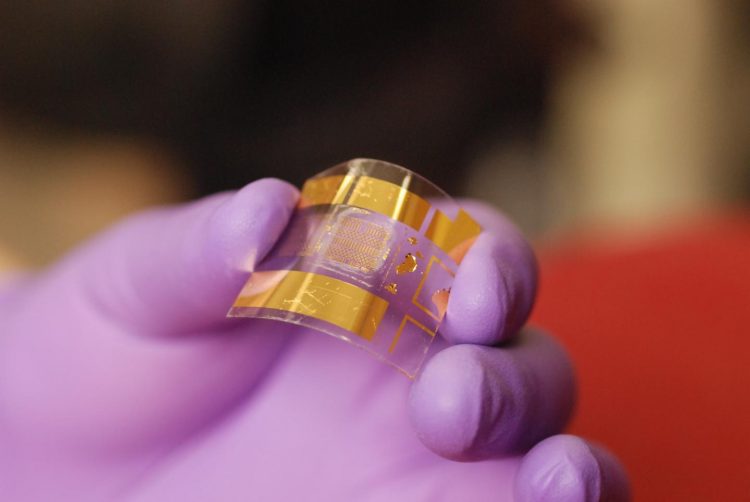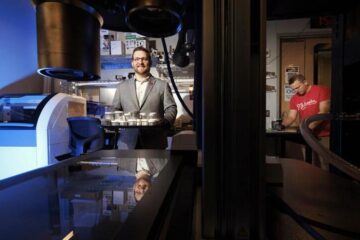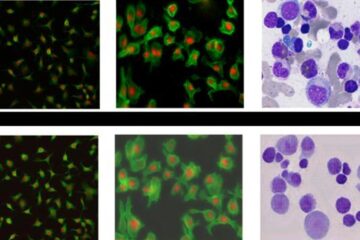A flexible new platform for high-performance electronics

Literal flexibility may bring the power of a new transistor developed at UW-Madison to digital devices that bend and move. Photo courtesy of Jung-Hun Seo, University at Buffalo, State University of New York
It's an advance that could open the door to an increasingly interconnected world, enabling manufacturers to add “smart,” wireless capabilities to any number of large or small products or objects — like wearable sensors and computers for people and animals — that curve, bend, stretch and move.
Transistors are ubiquitous building blocks of modern electronics. The UW-Madison group's advance is a twist on a two-decade-old industry standard: a BiCMOS (bipolar complementary metal oxide semiconductor) thin-film transistor, which combines two very different technologies — and speed, high current and low power dissipation in the form of heat and wasted energy — all on one surface.
As a result, these “mixed-signal” devices (with both analog and digital capabilities) deliver both brains and brawn and are the chip of choice for many of today's portable electronic devices, including cellphones.
“The industry standard is very good,” says Zhenqiang (Jack) Ma, the Lynn H. Matthias Professor and Vilas Distinguished Achievement Professor in electrical and computer engineering at UW-Madison. “Now we can do the same things with our transistor — but it can bend.”
Ma is a world leader in high-frequency flexible electronics. He and his collaborators described their advance in the inaugural issue of the journal Flexible Electronics, published Sept. 27.
Making traditional BiCMOS flexible electronics is difficult, in part because the process takes several months and requires a multitude of delicate, high-temperature steps. Even a minor variation in temperature at any point could ruin all of the previous steps.
Ma and his collaborators fabricated their flexible electronics on a single-crystal silicon nanomembrane on a single bendable piece of plastic. The secret to their success is their unique process, which eliminates many steps and slashes both the time and cost of fabricating the transistors.
“In industry, they need to finish these in three months,” he says. “We finished it in a week.”
He says his group's much simpler high-temperature process can scale to industry-level production right away.
“The key is that parameters are important,” he says. “One high-temperature step fixes everything — like glue. Now, we have more powerful mixed-signal tools. Basically, the idea is for flexible electronics to expand with this. The platform is getting bigger.”
###
His collaborators include Jung-Hun Seo of the University at Buffalo, State University of New York; Kan Zhang of UW-Madison; and Weidong Zhou of the University of Texas at Arlington.
This work was supported by the Air Force Office of Scientific Research (grant No. FA9550-09-1-0482).
Renee Meiller
608-262-2481
meiller@engr.wisc.edu
Media Contact
All latest news from the category: Power and Electrical Engineering
This topic covers issues related to energy generation, conversion, transportation and consumption and how the industry is addressing the challenge of energy efficiency in general.
innovations-report provides in-depth and informative reports and articles on subjects ranging from wind energy, fuel cell technology, solar energy, geothermal energy, petroleum, gas, nuclear engineering, alternative energy and energy efficiency to fusion, hydrogen and superconductor technologies.
Newest articles

Bringing bio-inspired robots to life
Nebraska researcher Eric Markvicka gets NSF CAREER Award to pursue manufacture of novel materials for soft robotics and stretchable electronics. Engineers are increasingly eager to develop robots that mimic the…

Bella moths use poison to attract mates
Scientists are closer to finding out how. Pyrrolizidine alkaloids are as bitter and toxic as they are hard to pronounce. They’re produced by several different types of plants and are…

AI tool creates ‘synthetic’ images of cells
…for enhanced microscopy analysis. Observing individual cells through microscopes can reveal a range of important cell biological phenomena that frequently play a role in human diseases, but the process of…





















